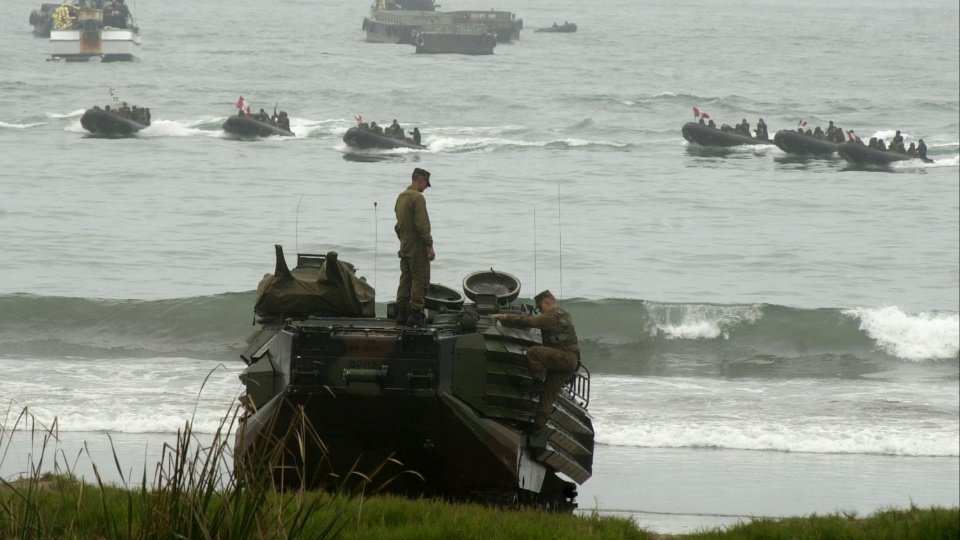
Beginning in June, detachments of U.S. troops will be arriving in Peru and staying until Dec. 31, 2023. Peru’s Congress, supported by only 6% of Peruvians, on May 26 approved a resolution introduced in January that “authorized the entry of naval units and foreign military personnel with weapons of war.”
Thanks to that decision, the U.S. military is now heading for Peru on a training and advisory mission. U.S. Army, Navy, and Air Force troops will be active throughout the country, with weapons and equipment in tow. The U.S. Southern Command appointed a Peruvian general as “deputy commanding general-interoperability.”
They arrive following massive popular protests that erupted in reaction to Peru’s right-wing Congress on Dec. 7, 2022, having ordered the arrest of the democratically-elected progressive President Pedro Castillo. The protests provoked violent military and police repression; over 70 Peruvians were killed. Demonstrations peaked in February, but they will revive in July, according to reports.
Castillo remains in prison, and his replacement, former Vice President Dina Boluarte, is widely reviled. The Inter-American Commission on Human Rights recently issued a report documenting “serious violations by the police and military” that took place shortly after she became president. Peru’s Public Ministry, investigating “the presumed crime of genocide,” required that Boluarte testify on June 6.
The U.S. troops will be arriving amid an upsurge of Peru’s underclass. The country’s mostly rural, poor, and Indigenous majority did elect the inexperienced Castillo as president in July 2021. They are now calling for Boluarte’s removal, new presidential elections, and a Constituent Assembly. Six of ten Peruvians regard the current political crisis as stemming from “racism and anti-indigenous discrimination,” according to a recent poll.
Resumen Latinoamericano reports that the U.S. forces heading to Peru will include 25 Special Forces troops arriving with weapons and equipment and 42 other Special Forces troops charged with preparing Peru’s intelligence command for “joint special operations;” 160 additional U.S. troops will be utilizing nine U.S. airplanes.
Eventually, 970 U.S. Air Force and Special Forces personnel will have taken part in the U.S. Southern Command’s so-called “Resolute Sentinel 23.” Previous U.S. military interventions in Latin America have been similarly named. The phrasing of this intervention’s official purpose is odd: “to integrate combat interoperability and disaster response training in addition to medical exchanges, training and aid, and construction projects.”
The coup government, under whose auspices the U.S. troops will be operating, is a creature of conservative political parties and the business establishment.
In April, it announced plans to privatize lithium mining, thus reversing Castillo’s efforts to nationalize the processing of the natural resource. The government is also easing the authorization procedures that enable foreign corporations to extract copper. Lawyer and former Castillo advisor Raúl Noblecilla cites control over Peru’s mineral wealth as the main reason why U.S. troops are in Peru; their presence there indicates “how lackey and sell-out governments function.”
Academician Jorge Lora Cam states that “the usurper government” seeks to “deepen extractive plunder with blood and fire…unify the right with left-leaning elements infected by neoliberalism…and prepare for permanent political power.” He adds that under the auspices of “political criminals,” the country’s economy is newly “at risk because Peru’s foreign debt now amounts to $100 billion.”
The imminent arrival of U.S. military forces provoked other criticism. Former Foreign Minister Héctor Béjar insisted that “the spurious government was using the presence of these troops to intimidate the Peruvian people, who have announced new protests for July.”
A spokesperson for the Communist Party of Peru-“Patria Roja” explained that, “the entry of U.S. troops in Peru is an affront to our sovereignty and represents explicit backing by the U.S. government of the nefarious Boluarte regime, which is responsible for repression against the Peruvian people.”
The U.S. military, of course, has long interacted with its Peruvian counterpart. Instances include: military exercises in 2017, “Regional Emergency Operations Centers” in 2018, a “naval mission in 1920,” U.S. Army involvement “from 1946 to 1969,” and U.S. training of thousands of Peruvian military personnel from the 1940s on.
TeleSur in 2015 reported that “Hundreds of Peruvians protested Wednesday…against the [anticipated] arrival of 3,200 [U.S.]soldiers with ships, airplanes, and various kinds of weapons.”
Peruvians are hardly alone as a targeted people. Some 800 U.S. bases are distributed throughout the world, and “173,000 troops [were] deployed in 159 countries as of 2020.” Military intrusion has extended for decades, in Peru and around the world. What’s the cost, and how are payments arranged for?
The projected U.S. military budget for FY 2024 exceeds $1.5 trillion, according to a recent analysis. There are two sets of military activities and each requires its own funding approach. The U.S. government has to pay for potential war against enemies like China and Russia and for military operations elsewhere.
To portray China and Russia as threats to the U.S. status quo garners so much attention as to spark fellow feeling for the military-industrial complex, and so…the funding flows. Rationales for the other kinds of involvement may lack crowd appeal—like shoring up the worldwide capitalist economy, serving corporate interests, and countering leftist insurgencies.
But Congressional generosity in response to exaggerated threats to the U.S. status quo and to the worldwide capitalist system may translate into so much funding that enough is left over to pay for U.S. meddling in the other countries.
Panama may be one of them: The Biden administration could be on the verge of sending U.S. troops to the Darién region of that country “to counter illicit drug trafficking, human trafficking, and irregular immigration.”
We hope you appreciated this article. At People’s World, we believe news and information should be free and accessible to all, but we need your help. Our journalism is free of corporate influence and paywalls because we are totally reader-supported. Only you, our readers and supporters, make this possible. If you enjoy reading People’s World and the stories we bring you, please support our work by donating or becoming a monthly sustainer today. Thank you!










